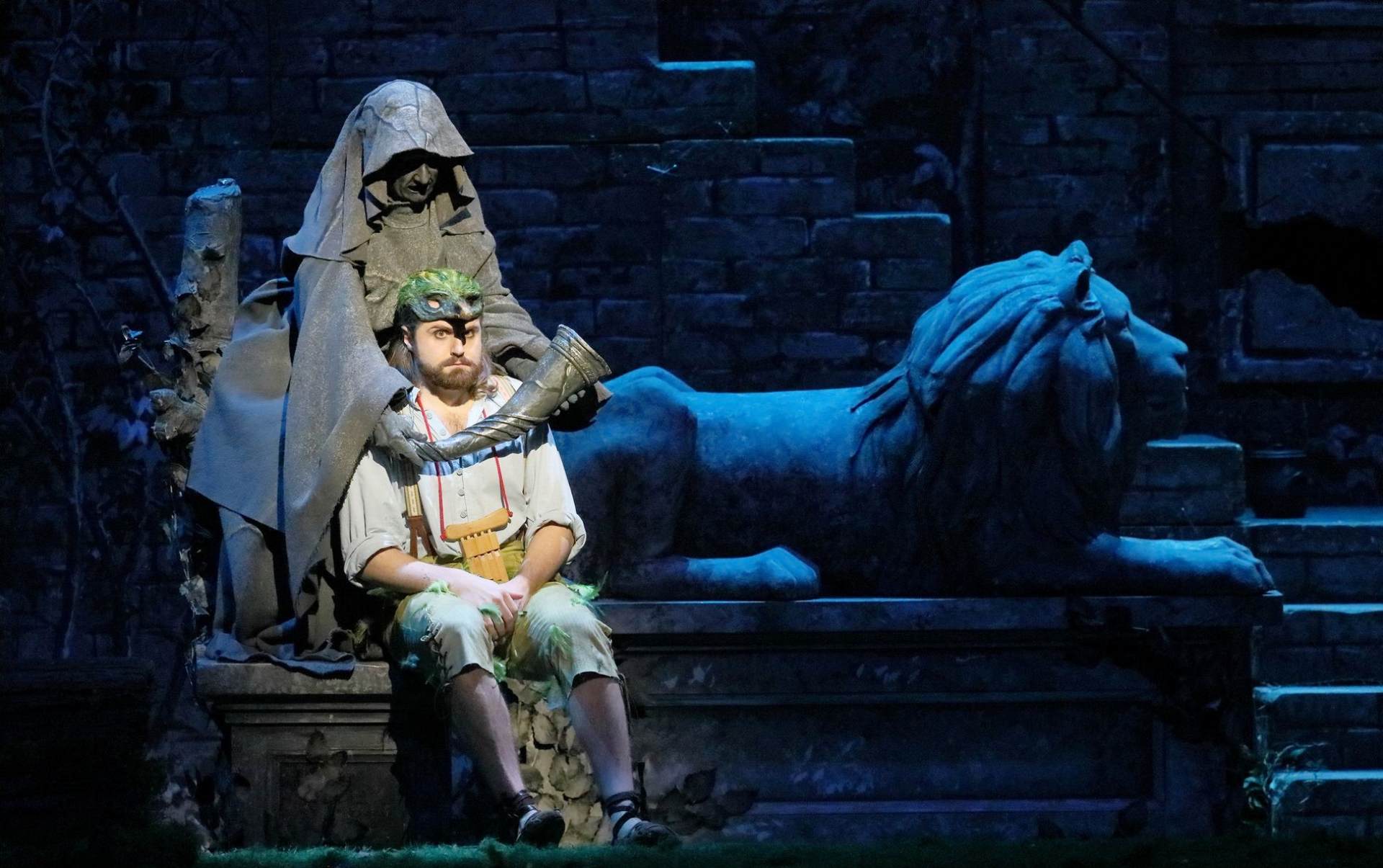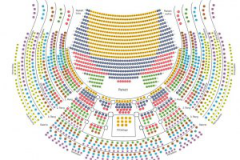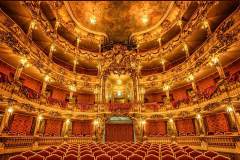The Magic Flute
Mo | Tu | We | Th | Fr | Sa | Su |
A German Opera in two acts (1791)
recommended for 6 years and older
Background
When Pamina's father died his wife, the Queen of the Night, lost her power, because he had handed the seal of the seven circles of the sun to the initiates. Sarastro is now administering the Sun King's legacy.
The Queen of the Night is not willing to submit to being directed by the wise men around Sarastro. She endeavours to regain her former power.
In order to foil her plans, Sarastro has kidnapped Pamina, who is actually her father's heir.
Act One
The Queen of the Night has chosen Prince Tamino to free her daughter. Pursued by a huge snake from which he is endeavouring to escape, the prince stumbles into the realm of the Queen of the Night and falls unconscious from exhaustion. Three ladies, attendants of the Queen of the Night, save his life.
When Tamino awakes, he discovers the snake lying dead at his feet. He meets Papageno and assumes that the bird-catcher has rescued him from the snake. Papageno does not contradict him and is punished for his boasting by the three ladies. They show Tamino a picture of Pamina and he immediately falls in love with her.
When the Queen of the Night herself appears on the scene, Tamino swears to deliver her daughter from the hands of the "demon" Sarastro. Tamino and Papageno, who is to accompany the prince, are given magical instruments to protect them from danger: a flute and a set of chimes. Three youths or genii are to accompany them on their journey to Sarastro's palace.
Tamino has sent Papageno on ahead, and the latter meets Monostatos, who is keeping guard over Pamina and pursuing her with unwelcome attentions. Papageno's appearance puts Monostatos to flight. Pamina now learns from Papageno that a prince, who is in love with her, is coming to set her free. Papageno persuades Pamina to flee.
In the meantime, Tamino has been led to Sarastro's temple by the three youths. A priest, a spokesman of the initiates, emerges and informs him about Sarastro's real character, assuring him that he is a kind, wise man and also telling him of Sarastro's plan. Tamino also learns that Pamina is still alive. In his gratitude he plays the flute, the magic of which tames wild animals. Monostatos and his slaves catch up with Papageno and Pamina but they are able to free themselves again with the help of the set of chimes. Their plan to escape is then foiled again by the arrival of Sarastro.
Pamina and Tamino meet for the first time and fall into each other's arms. Monostatos drags them apart, but, instead of the reward he expects for his services, he is punished by Sarastro.
Tamina and Papageno are led into the Temple of Ordeal.
Act Two
Sarastro informs the initiates of his plan to lead Tamino to a greater destiny and the priests approve his decision. Tamino, however, must first prove himself worthy of the greater happiness by submitting to the ordeals. Pamina and Tamino must take their leave of each other. Papageno is also to be put to the test. First of all, both he and the prince are enjoined to silence.
Tamino does not allow himself to be tempted by the three ladies of the Queen of the Night who have sneaked into the temple. In the meantime, the Queen of the Night has managed to reach her daughter and orders Pamina to kill Sarastro. Pamina cannot do this. Monostatos, who has overheard the Queen talking to her daughter and is
blackmailing Pamina by threatening to reveal all, is chased away by Sarastro. Sarastro is aware of Pamina's predicament and is able to reassure her.
While Tamino and Papageno are awaiting further ordeals, an old crone appears and introduces herself as Papageno's sweetheart. Before she can tell them her name, there is a clap of thunder and a flash of lightning and she disappears. Tamino plays his flute, the sound of which guides Pamina to him. She speaks to him but, not knowing that he has been enjoined to silence, she believes he does not love her any longer when she gets no answer. Life no longer seems worth living to her.
Sarastro considers Tamino to be capable of ruling as a wise prince, once he has surmounted the two last ordeals. Papageno, on the other hand, has failed and is afraid that he will be thrown into a dungeon for the rest of his life if he does not take the old crone as his wife. When he reluctantly agrees to do so, Papagena reveals herself as a young and attractive woman. The two of them are, however, still destined not to be united yet.
In her despair, Pamina is contemplating suicide. The three youths restrain her and lead her to Tamino, who is awaiting the final ordeals at the "Gate of Fear". Accompanied by the music of the magic flute, the two of them undergo the ordeals by fire and water together and overcome despair and the fear of death.
In the meantime the three youths have brought Papageno and his Papagena together. The Queen of the Night and her ladies make a last bid for revenge by trying, in vain, to storm Sarstro's palace and are cast into endless night.
Tamino and Pamina are welcomed into the temple by Sarastro and the priests.
© Bavarian State Opera
Program and cast
Composer Wolfgang Amadeus Mozart. Libretto by Emanuel Schikaneder.
In German language. Without surtitles due to the stage design.
Duration approximately 3 hours 15 minutes
Conductor: Nikolaj Szeps-Znaider
Production: August Everding
Set Design: Jürgen Rose
Lighting: Michael Bauer
Choreography: Beate Vollack
Choruses: Franz Obermair
Sarastro: Tareq Nazmi
Tamino: Giovanni Sala
Sprecher: Martin Snell
Königin der Nacht: Jessica Pratt
Pamina: Ying Fang
Erste Dame: Erika Baikoff
Zweite Dame: Emily Sierra
Dritte Dame: Avery Amereau
Drei Knaben: Solist(en) des Tölzer Knabenchors
Papageno: Konstantin Krimmel
Papagena: Seonwoo Lee
Monostatos: Kevin Conners
Erster Geharnischter: Samuel Stopford
Zweiter Geharnischter: Roman Chabaranok
Erster Priester: Martin Snell
Bayerisches Staatsorchester
Chorus of the Bayerische Staatsoper
National Theatre Munich
The National Theatre Munich (German: Nationaltheater München) is an opera house in Max-Joseph-Platz in Munich, Germany. It is the home of the Bavarian State Opera and the Bayerisches Staatsballett(Bavarian State Ballet).
The Bavarian State Opera also performs in the Prinzregententheater, which opened in 1901 and, like the Bayreuth Festspielhaus, is built to Richard Wagner's specifications, and in the Cuvilliés Theatre at the Residenz, constructed in 1751–1753 and described by Thierry Beauvert as "a Rococo gem".
The Nationaltheater is very easy to get to both by car and by MVV public transportation.
By MVV public transportation
S-Bahn: S 1 - 8 Marienplatz
U-Bahn: U 3, 6 Marienplatz, U 3 - 6 Odeonsplatz
Bus: 52, 131 Marienplatz, 100 Odeonsplatz
Straßenbahn: 19 Nationaltheater
On the day of the performance, holders of regular tickets are entitled to use public transport provided by the Münchner Verkehrsverbund (MVV). This service starts at 3 pm respectively three hours before the performance commences and ends with the closing hour of the MVV.
By Car
Take the Altstadt-Ring to Maximilianstraße.
Parking garage Max-Joseph-Platz: open Monday to Sunday from 6:00 A.M. to 2:00 A.M.
You can take advantage of the special theatre parking fee of Euro 10,- from 6:00 P.M. to 8:00 A.M. by presenting your admission tickets.

 EN
EN DE
DE IT
IT FR
FR ES
ES RU
RU JP
JP RO
RO
 Seating plan
Seating plan 
